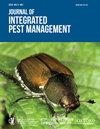Spotted cucumber beetle/southern corn rootworm: profile of a polyphagous native pest
IF 2.7
3区 农林科学
Q1 ENTOMOLOGY
引用次数: 1
Abstract
Abstract Spotted cucumber beetle, Diabrotica undecimpunctata (Coleoptera: Chrysomelidae), a North American native leaf beetle species also known as southern corn rootworm (SCRW), is a polyphagous pest of various crops including cucurbits (Cucurbitaceae), corn (Zea mays), soybeans (Glycine max), snap beans (Phaseolus vulgaris), peanut (Arachis hypogaea), and sweetpotato (Ipomoea batatas). Larvae are below-ground pests of corn, sorghum (Sorghum spp.), peanut, and sweetpotato. Adult damage impacts cucurbits by damage to seedlings and fruit and transmission of bacterial wilt (causal agent Erwinia tracheiphila) by eastern populations. Adult feeding also damages fresh market beans and occasionally leafy and fruiting vegetables. Damage on many other crops such as field soybeans, dry beans, and sorghum, is often cosmetic and/or inconsequential. Adults overwinter in mild climates and spread seasonally northward, with multiple generations and populations increasing into the late summer. Diverse natural enemies attack all stages, but their ecology and impact are poorly known, particularly below ground. A female-produced sex pheromone and floral volatiles are known attractants, and cucurbitacins (bitter phytochemicals) are feeding stimulants, offering potential selective behavioral control. Management practices are directed against pest complexes, including other below- and above-ground pests, depending on the crop. Chemical controls are soil-applied for protection from root-feeding larvae, systemic seed treatments for early-state crop feeding, and broadcast application in fruiting cucurbits and beans. Action thresholds and monitoring are not well developed. Cultural controls include field and cultivar choice, row covers in high-value crops, and available crop resistance. The wide host range, abundance, and mobility of adults make prediction and monitoring challenging.斑点黄瓜甲虫/南方玉米根虫:一种多食性本地害虫的概况
摘要斑点黄瓜甲虫(Diabrotica decimpunctata)是一种北美本土叶甲虫,又称南方玉米根虫(SCRW),是一种多食性害虫,主要寄生于葫芦科(Cucurbitaceae)、玉米(Zea mays)、大豆(Glycine max)、豆角(Phaseolus vulgaris)、花生(Arachis hypogaea)和甘薯(Ipomoea batatas)等多种作物。幼虫是玉米、高粱(高粱属)、花生和甘薯的地下害虫。成虫危害通过对幼苗和果实的损害以及在东部种群中传播细菌性枯萎病(致病因子)来影响葫芦。成人喂养也会损害新鲜的市场豆类,偶尔也会损害绿叶蔬菜和水果蔬菜。对许多其他作物的损害,如大田大豆、干豆和高粱,往往是表面的和/或无关紧要的。成虫在气候温和的地方越冬,季节性地向北扩散,多代繁殖,种群数量在夏末增加。各种各样的天敌攻击各个阶段,但它们的生态和影响却鲜为人知,特别是在地下。雌性产生的性信息素和花挥发物是已知的引诱剂,葫芦素(苦味植物化学物质)是进食刺激物,提供潜在的选择性行为控制。管理措施针对的是病虫害组合,包括其他地上和地下病虫害,视作物而定。化学防治是指施用于土壤以防止根系取食的幼虫,对作物早期取食进行系统的种子处理,以及在结果的葫芦和豆类上撒播。行动阈值和监测没有很好地制定。栽培控制包括田间和品种的选择,高价值作物的行盖,以及可用的作物抗性。寄主范围广、数量多以及成虫的流动性使预测和监测具有挑战性。
本文章由计算机程序翻译,如有差异,请以英文原文为准。
求助全文
约1分钟内获得全文
求助全文
来源期刊

Journal of Integrated Pest Management
Agricultural and Biological Sciences-Insect Science
CiteScore
5.80
自引率
3.60%
发文量
24
审稿时长
25 weeks
期刊介绍:
Journal of Integrated Pest Management is an open access, peer-reviewed, extension journal covering the field of integrated pest management. The Editors-in-Chief are Dr. Marlin E. Rice (formerly with Iowa State University) and Dr. Kevin L. Steffey (formerly with the University of Illinois). The journal is multi-disciplinary in scope, publishing articles in all pest management disciplines, including entomology, nematology, plant pathology, weed science, and other subject areas.
 求助内容:
求助内容: 应助结果提醒方式:
应助结果提醒方式:


